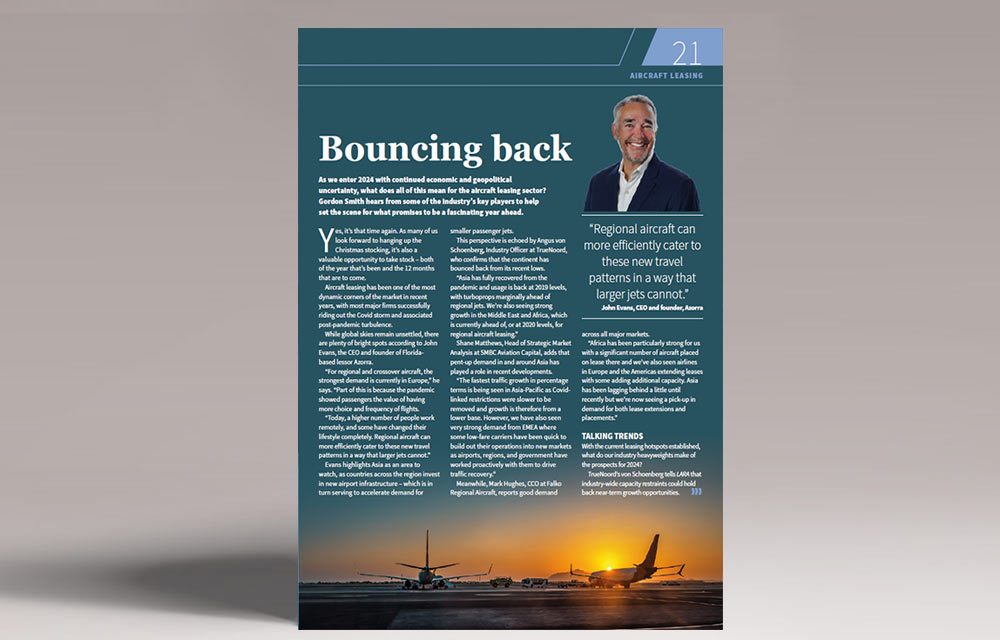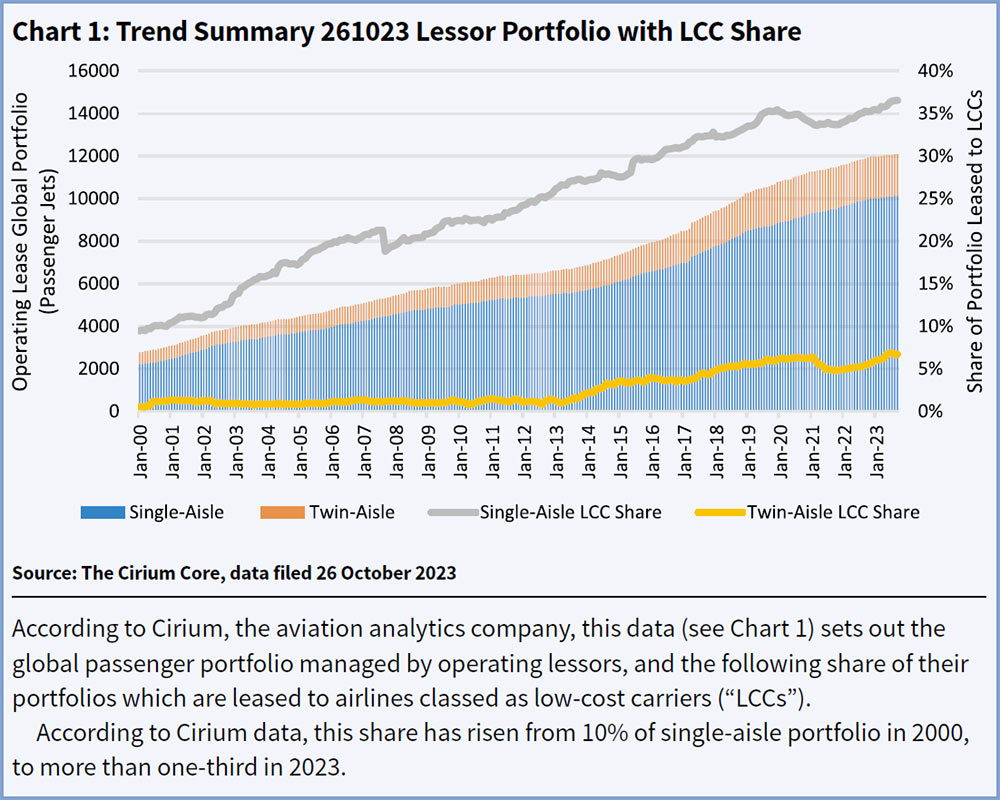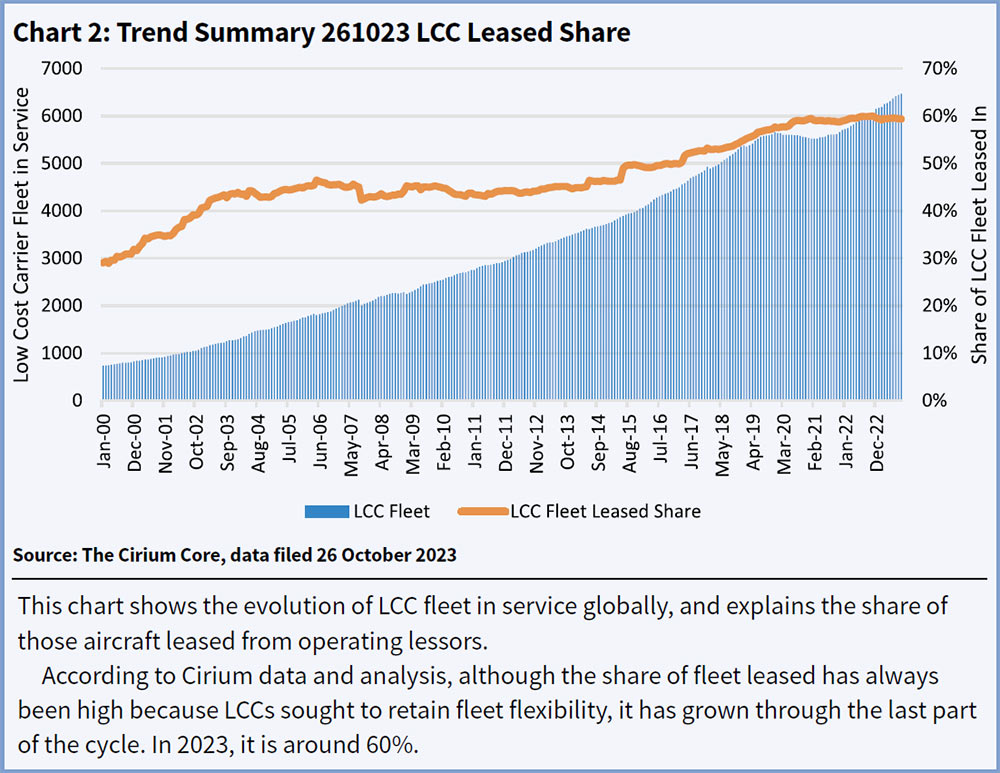
Bouncing back
As we enter 2024 with continued economic and geopolitical uncertainty, what does all of this mean for the aircraft leasing sector? Gordon Smith hears from some of the industry’s key players to help set the scene for what promises to be a fascinating year ahead.
Yes, it’s that time again. As many of us look forward to hanging up the Christmas stocking, it’s also a valuable opportunity to take stock – both of the year that’s been and the 12 months that are to come.
Aircraft leasing has been one of the most dynamic corners of the market in recent years, with most major firms successfully riding out the Covid storm and associated post-pandemic turbulence.
While global skies remain unsettled, there are plenty of bright spots according to John Evans, the CEO and founder of Floridabased lessor Azorra.
“For regional and crossover aircraft, the strongest demand is currently in Europe,” he says. “Part of this is because the pandemic showed passengers the value of having more choice and frequency of flights.
“Today, a higher number of people work remotely, and some have changed their lifestyle completely. Regional aircraft can more efficiently cater to these new travel patterns in a way that larger jets cannot.”
Evans highlights Asia as an area to watch, as countries across the region invest in new airport infrastructure – which is in turn serving to accelerate demand for smaller passenger jets.
This perspective is echoed by Angus von Schoenberg, Industry Officer at TrueNoord, who confirms that the continent has bounced back from its recent lows.
“Asia has fully recovered from the pandemic and usage is back at 2019 levels, with turboprops marginally ahead of regional jets. We’re also seeing strong growth in the Middle East and Africa, which is currently ahead of, or at 2020 levels, for regional aircraft leasing.”
Shane Matthews, Head of Strategic Market Analysis at SMBC Aviation Capital, adds that pent-up demand in and around Asia has played a role in recent developments.
“The fastest traffic growth in percentage terms is being seen in Asia-Pacific as Covidlinked restrictions were slower to be removed and growth is therefore from a lower base. However, we have also seen very strong demand from EMEA where some low-fare carriers have been quick to build out their operations into new markets as airports, regions, and government have worked proactively with them to drive traffic recovery.”
Meanwhile, Mark Hughes, CCO at Falko Regional Aircraft, reports good demand across all major markets.
“Africa has been particularly strong for us with a significant number of aircraft placed on lease there and we’ve also seen airlines in Europe and the Americas extending leases with some adding additional capacity. Asia has been lagging behind a little until recently but we’re now seeing a pick-up in demand for both lease extensions and placements.”
TALKING TRENDS
With the current leasing hotspots established, what do our industry heavyweights make of the prospects for 2024?
TrueNoord’s von Schoenberg tells LARA that industry-wide capacity restraints could hold back near-term growth opportunities.
“Strong demand is currently hindered by supply chain issues and a lack of pilots,” he says.
“A particular problem is the amount of time that shop visits are taking with aircraft remaining on the ground for longer. If they are parked for too long, the work simply becomes uneconomical to perform.
“We also see the sale and leaseback business increasing in 2024 as deliveries of new orders impact the global fleet. Operators with mid-life aircraft will want to reduce their residual value exposure, and leasing can present the ideal solution for current generation aeroplanes.”
Hughes broadly agrees, noting that the supply chain is impacting “everything from new aircraft deliveries to returning older aircraft to service”. He describes the problem as “a constraint on airline capacity that will definitely continue into 2024”.
Although the Falko CCO predicts some softening in the economic climate, he strikes an optimistic note in suggesting that air travel overall is looking relatively resilient.
Matthews from SMBC also notes that within the low-fare sector, a shift towards upscale options is also worth watching.
“There have been some moves by LCCs to introduce more premium services and products and we think this will continue in 2024, as consumers seem willing to pay for more space, baggage or convenience,” he says.
“While LCCs may also look to increase their operations at the primary airports, this may be restricted by the fact that the full-service carriers are building up their long-haul operations and slots may become more scarce.”

EMBRAER INSIGHTS
Firmly established as a mainstay of the regional scene, Embraer’s E-Jet Family continues to prove hugely popular.
Despite the arrival of the more modern E2, its older sibling remains a top choice for many global operators, says Evans.
“We’re seeing demand for E1 jets from across multiple markets, including flag carriers such as SAS.
“We believe the aircraft has proven itself to be very reliable, having experienced the same teething issues as most new-generation aircraft.
“Crossover types such as the E1 are an attractive option for regional airlines as they typically offer lower cost-per-trip than narrowbody jets, for a similar cost-per-seat. However, from a leasing perspective, the crossover market is currently much less competitive than that for narrowbody jets.”
The E1’s popularity is likely to continue, says von Schoenberg.
“The E1 is not an old aircraft – it uses 21st century technology and fulfils its role admirably. It’s a reliable model with flexible seat capacity, and although there is some availability it is tightening due to demand.”
The TrueNoord Industry Officer believes two key factors will contribute to ongoing interest in the E1 as we enter 2024: delayed Airbus A220 and Embraer E2 production, and A320 shop visits for GTF engine repairs.
“These will drag the E190 and E195s further into the limelight for operators seeking to maintain capacity,” he says.
While much has been said about lacklustre interest in the Brazilian OEM’s flagship passenger jet, in 2023 it felt as though the E2 finally made substantial progress.
In June, Falko accepted its fifth E195-E2, representing the final delivery in a five-aircraft sale and leaseback transaction with Porter Airlines.
The Canadian regional was the North American launch customer for the type, while the Porter deal heralded Falko’s first foray into the E2 market.
E2 EVOLUTION
Azorra too has been busy with the E2 in Canada, striking a major deal with Porter.
“When the E2 was first developed, the aircraft was before its time and struggled to gain a foothold in the market, partly because there wasn’t enough drive to replace current generation E1s,” says Evans.
“Most airlines between 2015 and 2019 were looking to upsize their fleets to include bigger aircraft, placing downward pressure on the value of E-Jets.”
The Azorra founder and CEO believes that recent global events have ultimately helped bolster interest in the E2.
He highlights that there are currently more than 70 operators globally that have E1 jets in their fleets, but eventually these will need to be replaced.
While the A220 is often a viable alternative, there is a well-documented backlog of orders at the European OEM.
The earliest official slots for new deliveries of the A220 are currently in 2027. By contrast, Embraer has more diary flexibility for additional units from smaller regional players.
Von Schoenberg from TrueNoord describes the E2 as having had “some significant order success” to the point where it is “beginning to catch up with the A220”.
Alongside Azorra, the lessor has also played a key role in facilitating Porter’s E2 fleet, with the Toronto-based airline representing TrueNoord’s first Canadian lessee. Despite a lengthy backlog putting the A220 out of immediate reach for some lessors and lessees, 2023 saw sustained interest in the type.
Given his firm’s existing exposure to both the -100 and -300 variants of the crossover jet, LARA asked if Evans welcomes the launch of a possible -500 “stretched” version in 2024?
“The A220 is a great aircraft and the newest technology aircraft in service today,” he says. “We believe it has room to continue developing, although Airbus may be reluctant because it crosses into their A320 markets and has already replaced the A319, but the -500 variant would be a terrific market for that aircraft.”
The latest Airbus model is also on the radar of TrueNoord.
“We want diversity across our fleet,” says von Schoenberg. “Some of the A220 crossover jets currently flying are reaching three to five years old now – likely the right vintage for TrueNoord. We keenly anticipate adding such aircraft to our fleet over time.”

THE OLD FAITHFUL
With so much industry chatter focussed on the latest models from Airbus, Boeing, and to a lesser extent Embraer, what might 2024 hold for the turboprop scene?
For Mark Hughes from Falko, predictions of the sub-sector’s demise are largely unfounded.
“There’s been a misconception that the turboprop market went away in some form, but demand has always been strong and it will continue,” he says.
“Part of this has been the incorrect association that the number of aircraft in storage reflects demand for the type, which is wrong.
“Most databases show upwards of 200 ATRs in storage, but the reality in the market is that there are almost no serviceable aircraft available today if you’re an airline that is looking. There’s a story behind every single one.”
The Falko CCO highlights MRO constraints as being an important factor in turnaround times for turboprops re-entering the market.
“There are a number of aircraft where the time needed to return the aircraft to service is very protracted, as unserviceable components have to go through overhaul with almost no spares available.
“We manage a number of aircraft where there is demand but we can’t get them into delivery condition in the time frame needed for the operator. They are in storage but not available and we’re working to get them back to service.
“Add in the fact that there’s a very small number of ATRs on order and it will be tough to even maintain supply to meet current levels of turboprop demand as the fleet ages.”
Meanwhile, von Schoenberg reports that although turboprops serve a valuable role within many markets, as a type they are lagging behind the European industry average.
“The rest of the world is fast approaching recovery,” he says. “However, turboprops remain around 20% down in Europe – mainly due to a number of carriers no longer operating the Dash 8-400 including airBaltic and LOT Polish Airlines. The demise of Flybe, previously the world’s largest operator of the type, has also been a factor.”
According to TrueNoord, the ATR 72 is the turboprop with the highest demand globally thanks to its low operating costs.
However, as Evans explains, the market isn’t for everyone – even among lessors who currently hold the types.
“Turboprops aren’t currently of interest to Azorra, and while we do own turboprop aircraft, we don’t plan to grow our fleet any further and may even look to sell those we do own.”
MORE SUSTAINABLE
After losing some momentum during the peak of the pandemic, sustainability has returned as one of the hottest topics in the industry, and it looks likely that this drive for change will only intensify as we enter 2024.
Orla Benson, SVP of ESG at SMBC Aviation Capital, confirms that sustainability is becoming a higher priority for the company’s customers, particularly those based in Europe and the United States, and that this demand would continue into 2024.
“This has been evident in RFPs from airlines where there is a sustainability element in the request,” she says.
“It could range from a request for sustainability credentials to requirements on how we can provide an innovative solution to assist an airline with its decarbonisation objectives.
“It is very positive to see these types of developments and we hope in time to be in a greater position to offer a basket of sustainability solutions to airlines and to tie these into our leasing products.”
However, as Mark Hughes from Falko explains, there aren’t many straightforward, quick fixes.
“At this stage there are very limited options outside of aircraft powered by jet fuel and we’re unlikely to see major shifts in demand until it’s clear what the long-term replacement options will be. That said, we’re keeping a close eye on developments so we can understand how to help that transition when the industry is able to successfully and safely introduce these new technologies.”
Von Schoenberg is similarly pragmatic, emphasising the need for technology to catch up with the needs of the industry.
“It’s too early to say that demand is changing because new technology aircraft do not exist yet,” he says. “They are not flying and they are not certified. Wealthy countries like Norway may pay a premium for these options as soon as they are viable, but we are still a long way off.
“With current engines, not much more can be achieved, but in the meantime there are incremental things that can be done to improve operational efficiency – such as better flight path management to shorten journeys and weight reduction of aircraft overall.”
Article courtesy of LARA
If you’d like to download a copy of the article you can do so by clicking here
15 December 2023

